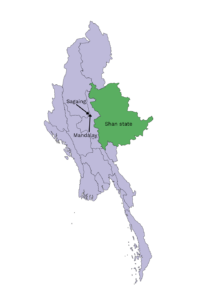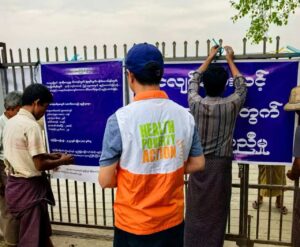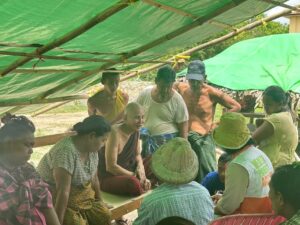
The above map shows the three areas we are currently working on earthquake relief, created on mapchart.net.
Health Poverty Action have distributed solar-powered torches, tarpaulins, and cash to 858 households, reaching over 3,000 people in camps in Amarapura Township, one of the worst affected areas of Mandalay.
Our team was impressed by the strength and speed of the response from Myanmar civil society. In Mandalay, food and bottled water are now widely available for everyone whose homes were damaged or destroyed. Local markets have quickly recovered, and essential items like food, fuel, and drinking water are accessible. However, shelter, clean water, and functioning sanitation facilities are still urgently needed, especially for families sleeping in temporary camps or on the street.
Government action on the ground has so far been limited. While several countries sent rescue teams, many had already begun to leave by the time our team arrived. Local civil society groups have stepped up impressively to meet immediate needs, but their resources are being stretched, and their efforts need external support to remain sustainable in the weeks to come.

The earthquake disproportionately affected poor communities, especially those whose homes were built without expensive materials, or earthquake-resilient engineering. As our team conducted assessments in Nay Pyi Taw, Mandalay, and Sagaing Division, they saw firsthand the extent of the damage. Immediate needs in Nay Pyi Taw were mostly covered by local civil society organisations, so the team prioritised the worst affected communities in Mandalay and Shan State.
Water and sanitation facilities are urgently needed. The team has started working with local authorities and civil society organisations to plan and implement a three-month project to repair these essential facilities in both Sagaing and Mandalay. These services are key to preventing outbreaks of communicable diseases, including skin infections, dengue fever, malaria, and dysentery. Worryingly, there is little sense of urgency from the local health authorities, so our team has made disease prevention a top priority.

In the face of these challenges, we are encouraged by the acts of solidarity and compassion we’ve witnessed. In some communities, Muslim and Buddhist religious leaders have come together to ensure that aid was shared equally. They met with our staff to help prioritise support for affected households.
While our immediate focus is on prevention and protection, our team is also assessing how we can respond to long-term needs. This includes rebuilding homes, particularly for families who do not have the resources to do so themselves, as well as rebuilding public facilities and restoring livelihoods for those most affected by the earthquake.
Thank you for standing in solidarity with communities in Myanmar.

